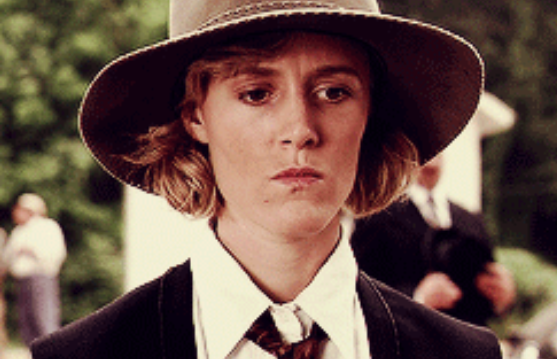
A Question That Still Haunts Viewers
More than three decades after its release, Fried Green Tomatoes continues to captivate audiences—not only for its storytelling and emotional power but for one of its most compelling unanswered questions: Was Ninny Threadgoode actually Idgie in disguise?
The film, directed by Jon Avnet and based on the novel by Fannie Flagg, never definitively answers the question. And yet, the clues are everywhere—woven through glances, gestures, and subtle lines of dialogue. Fans and critics alike have spent years debating the possibility that the sweet, eccentric old woman who tells Evelyn all about Whistle Stop isn’t simply a storyteller, but the story’s heroine herself.
This mystery, while left unresolved in the film, is not just a clever narrative device. It’s also a profound meditation on memory, identity, love, and the ways we preserve our stories—even when the world doesn’t give us permission to tell them outright.
Clue #1: Ninny’s Intimate Knowledge of Idgie’s Life
One of the most obvious hints that Ninny might be Idgie is how intimately she knows the details of Idgie Threadgoode’s life. While she explains to Evelyn that Idgie was her sister-in-law, her storytelling goes far beyond what a family member might typically recall.
She knows exactly how Idgie reacted to Buddy’s death, how she jumped trains, how she rescued Ruth, and even how she helped cover up Frank Bennett’s murder. The depth of her knowledge—including private conversations and inner motivations—feels firsthand, not secondhand.
Some might argue that in a small town like Whistle Stop, everyone knows everyone’s business. But Ninny’s voice takes on a different tone when talking about Idgie. She doesn’t just recount the story—she inhabits it.
Clue #2: The Honey and the Final Revelation
In one of the final scenes, Evelyn returns to Whistle Stop to find that Ninny is gone from the nursing home. A local caretaker tells her that Ninny left after her friend’s funeral and never came back.
As Evelyn wanders through the now-abandoned town, she visits Ruth and Idgie’s old house—and finds a jar of honey and pecans, with a note addressed to her. The contents are significant because Idgie and Big George were known for selling honey with whole pecans inside, sourced from their secret beehive spot.
The suggestion is clear: Idgie is still alive and left the gift for Evelyn as a quiet goodbye—or hello. But the person who left the jar also knew Evelyn personally, well enough to know she would return. Only Ninny fits that description.
If Ninny and Idgie are separate people, how would Ninny know to leave the jar and note? But if Ninny is Idgie, the mystery is elegantly resolved.
Clue #3: A Smile That Tells Everything

There’s one moment—brief, easy to miss—when Evelyn confronts Ninny in the final scenes and says, “You knew her better than anybody.” Ninny smiles and replies, “I guess I did.”
It’s not the line that stands out so much as the smile. It’s the smile of someone who’s holding back a secret with deep affection. It’s not mischievous, but wistful. It suggests a truth too precious—or too dangerous—to say aloud.
That smile, perhaps more than any other moment in the film, is what fuels the theory that Ninny and Idgie are one and the same. In a movie that trades in emotional subtlety and unspoken truths, it’s a quiet wink to the audience.
Why Would She Hide Her Identity?
If Ninny is Idgie, then why wouldn’t she just say so?
The answer lies in the world Fried Green Tomatoes portrays. Idgie was always unconventional: a tomboy who defied gender roles, a woman who lived with another woman in an era when such things were taboo, and a person suspected of criminal acts (even if done out of protection and love).
By the time she becomes Ninny—an elderly woman in a Southern nursing home—it’s possible that she chose to let her old identity fade. The world wasn’t kind to women like Idgie. Becoming “Ninny” might have been a way to live safely in her later years, to blend in while still preserving her memories through story.
In this light, her storytelling to Evelyn becomes a gentle passing of the torch. By telling Evelyn who Idgie was, she’s really showing her how to become her.
The Book vs. the Film: What Does Fannie Flagg Say?
In the original novel, the identity of Ninny and Idgie is more clearly separated. Fannie Flagg presents them as distinct characters, though the narrative structure still allows for complexity and ambiguity.
However, film adaptations often take liberties—and Jon Avnet’s film makes some deliberate choices to blur the lines between the two women. The casting of Jessica Tandy as Ninny and Mary Stuart Masterson as Idgie creates visual distance, but the emotional throughline remains suspiciously strong.
In interviews, Flagg has embraced the ambiguity, often smiling when asked if Ninny was Idgie. Her response? “If that’s what you think, then maybe it’s true.” That literary shrug gives viewers permission to draw their own conclusions.
What It Means if Ninny Is Idgie
If we accept that Ninny is Idgie, it adds tremendous emotional weight to the entire film. Suddenly, we’re no longer watching a sweet old woman reminiscing about a loved one. We’re watching a woman tell the story of her own life, cloaked in fiction, because it’s the only way she can survive in a world not ready to hear it.
It also reframes her relationship with Evelyn. Ninny isn’t just telling stories—she’s mentoring Evelyn, showing her the path to self-liberation. The stories of Idgie’s defiance, Ruth’s grace, Sipsey’s courage, and Big George’s loyalty aren’t just memories. They’re lessons. Survival manuals.
And in the end, Evelyn’s transformation becomes the proof that the story mattered—that it wasn’t told in vain.
Or Maybe It Doesn’t Matter at All
There’s another interpretation—just as powerful. Maybe Ninny isn’t Idgie. Maybe she’s exactly who she says she is: a loving sister-in-law, a good storyteller, a woman who lived alongside heroes and wants to ensure they’re not forgotten.
In this reading, Ninny becomes a different kind of guardian—a keeper of stories, not the protagonist but the one who ensures the protagonist’s voice survives. After all, not everyone who changes lives does so through action. Some do it through memory.
This view elevates the importance of listening, of preserving, and of passing on the fire of those who came before us.
Conclusion: A Truth Left Untold, Yet Fully Felt
So—was Ninny really Idgie?
The film doesn’t answer the question, and that’s what makes it so enduring. In the end, the truth lies in how we feel when we hear her speak. Whether Ninny is Idgie, or Idgie’s protector, or something in between, she carries the story of Whistle Stop in her bones.
She gives Evelyn more than memories. She gives her permission to live.
And maybe that’s the real point. It’s not about who Ninny was. It’s about who Evelyn becomes because of her.
